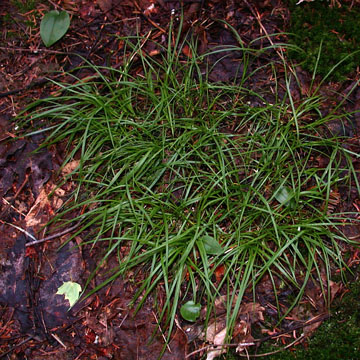

Carex novae-angliae - (image 1 of 6)
Taxonomy
Family: Cyperaceae
Section Acrocystis
Habitat
Moist woods.
Associates
Distribution
Newfoundland to southern Ontario and WI, south in mountains to CT, PA, and WV; possibly disjunct in SC.
Morphology
Loosely cespitose perennial; stems slender, 10-40 cm, shorter than the leaves; main leaves 1-2 mm wide, pale green; terminal spike staminate, slender, 4-16 mm; pistillate spikes 2-3, 3-6 mm long, 1-3 cm apart, the two lowest spikes not overlapping, the lowest one on a short peduncle; lowest bract foliaceous, often equaling or surpassing the inflorescence; pistillate scales stramineous or reddish-brown, the margins hyaline, acute or short-cuspidate; perigynia 2-10, light green to brownish-stramineous, minutely pubescent, 2.2-2.7 mm long, the body slightly flattened, obovoid above a stipe-like base, 2-keeled, abruptly contracted to a beak 1/4 to 2/5 as long as the body; achene rounded-trigonous.
Notes
Fruiting June to early July
Wetland indicator: FACU
Differs from other members of this section with slender leaves in that the lowest pistillate spike is well separated from the upper spikes and borne on a distinct peduncle.
References
Gleason, Henry A. and A. Cronquist. 1991. Manual of Vascular Plants of
Northeastern United States and Adjacent Canada. Second Ed.
The New York Botanical Garden. Bronx, NY
|
© Michael Hough 2018 |